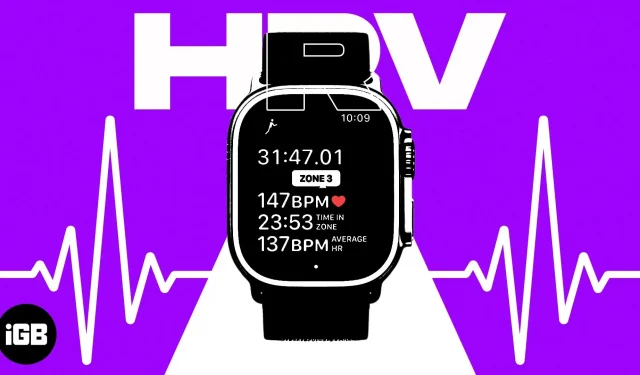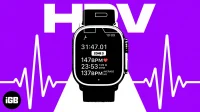Things to know before checking HRV on Apple Watch (watchOS 9):
- HRV is supported by Apple Watch Series 4 and later.
- User must be over 18 years of age
Measuring heart rate variability with your Apple Watch can provide important information about your heart rate and how you feel. HRV is an important indicator of your autonomic nervous system (ANS), the part of your nervous system that controls functions such as breathing, heart rate, and digestion.
By monitoring this critical metric, you can detect changes in your body’s stress levels and diagnose changes in health or energy. In this guide, I’ll walk you through how to track your HRV levels with your Apple Watch.
- Why is heart rate variability important?
- How to Track Heart Rate Variability on Apple Watch
- How to View HRV Readings on iPhone
- Factors affecting the accuracy of HRV measurement
Why is heart rate variability important?
Heart rate variability (HRV) is a term used to describe the change in time between each heartbeat. Measuring HRV has become a popular way to track your overall health and wellness, and the Apple Watch is one device that can help you do just that.
HRV can also be used as a way to measure progress when it comes to exercise and fitness. Training with a heart rate monitor can help athletes track their progress and reach their goals. This can help guide decisions about exercise intensity and duration, as well as help spot signs of fatigue and overtraining.
It can also detect changes in the body’s response to stress and exercise, leading to more accurate diagnosis and treatment of disease.
Overall, HRV is a valuable tool for assessing overall health and fitness, identifying changes in response to stress, and tracking fitness progress.
How to Track Heart Rate Variability on Apple Watch
- Before starting the breathing exercise, sit back and relax completely.
- Access the Mindfulness app from your Apple Watch.
- Select the “Breath”option from the function menu. Click “Continue”if you are using the app for the first time.
- Follow the instructions as shown. You will see options for inhalation and exhalation.
- The graphics on your watch will expand and contract, correcting the breathing you need to follow.
- The session will end when the watch vibrates twice and beeps. You may see a “Well Done”message.
- The following interface will show your heart rate in beats per minute (BPM) respectively.
- If you want to stop your session for some unavoidable reason, just swipe right and hit End.
The timer for this exercise is set to 1 minute by default. However, you can change it by clicking the three dots icon next to the breath logo → Duration → Set the timer accordingly.
Note. All notifications on Apple Watch will be turned off once a session has started to help you stay focused. If you struggle to receive incoming calls or make sudden movements, your session will automatically end and you will have to start the process over again.
How to View HRV Readings on iPhone
If you need a detailed view of your heart rate, you can get it from your iPhone in a few simple steps:
- Open the Health app on your iPhone.
- Tap the Browse option located in the lower right corner of the screen.
- Select the “Heart”option in the “Health Categories”section.
- To view a graphical representation of the same, tap on any indicator you need. We will now focus on heart rate variability.
- You can now view a detailed infographic about your heart condition. Readings are divided into days, weeks, months, 6 months and years.
- To explore a specific session, scroll down and click Show All Data from the Options menu.
- Now you can access any session of your choice from all recorded data. Each session is further classified in data sorted by time.
By following these steps, you can easily record and manage multiple heart readings at the same time without worrying about data loss from any spontaneous session.
Factors affecting the accuracy of HRV measurement
The relationship between heart rate and respiration is a measurement of heart rate variability that provides valuable information about many aspects of health. However, several factors can affect the accuracy of HRV measurements:
- For accurate readings, it is best to measure in a quiet, comfortable environment with minimal outside noise and ideal temperature.
- Any movement such as eating, drinking or smoking before or during the measurement can also affect the accuracy of the HRV measurement.
- It is best to measure HRV by continuous recording for several minutes. This will give a better average and provide a more accurate picture of overall HRV.
- Individuals with naturally faster or slower heart rates at rest or with pacemakers, are older, or have a history of heart disease can be caused by various measures of HRV.
Good HRV is important because it goes hand in hand with better overall health. It can be used to measure stress levels and can help with recovery and exercise. In contrast, low HRV is associated with an increased risk of heart disease and other health problems.
FAQ
To turn on heart rate measurement on your Apple Watch, open the Settings app on your watch and go to Privacy → Heart Rate. Make sure heart rate is turned on.
Yes, Apple Watch is capable of accurately measuring HRV using built-in heart rate sensors and various health monitoring features such as zone tracking. However, it’s important to note that the Apple Watch is not medical equipment and should not be relied upon for high-end diagnosis or treatment. Any concerns should be discussed with a healthcare professional.
It is so simple!!!
The Apple Watch’s built-in heart rate monitor and health app on iPhone make it easy to keep track of your heart rate. It is important to remember to take frequent measurements and consult your doctor if you are concerned about the health of your heart.
With regular HRV monitoring, you can ensure that your body is functioning at its optimal level.


